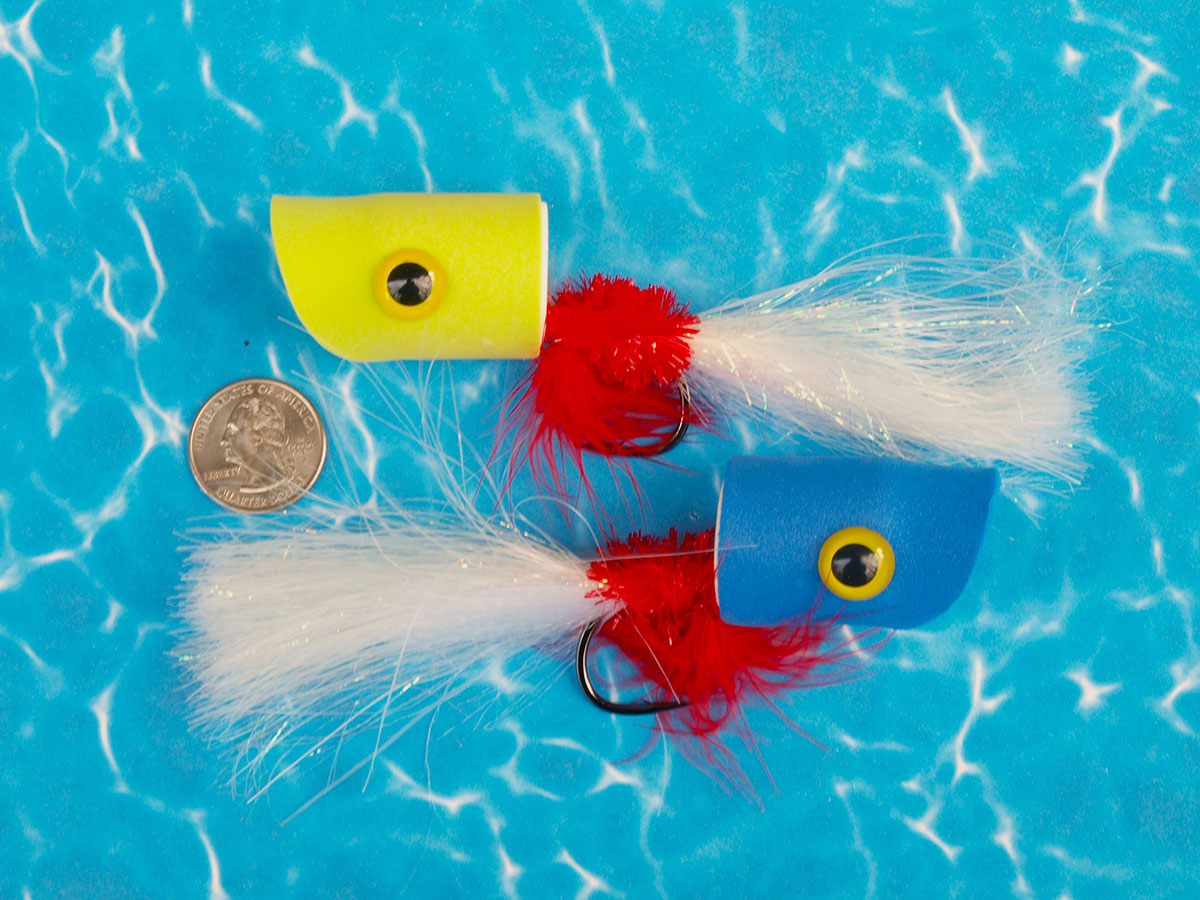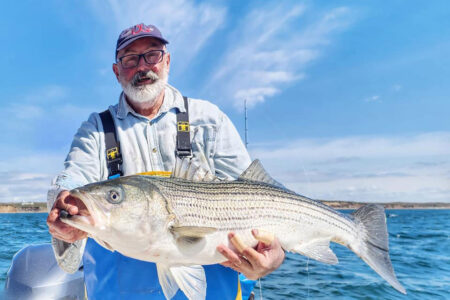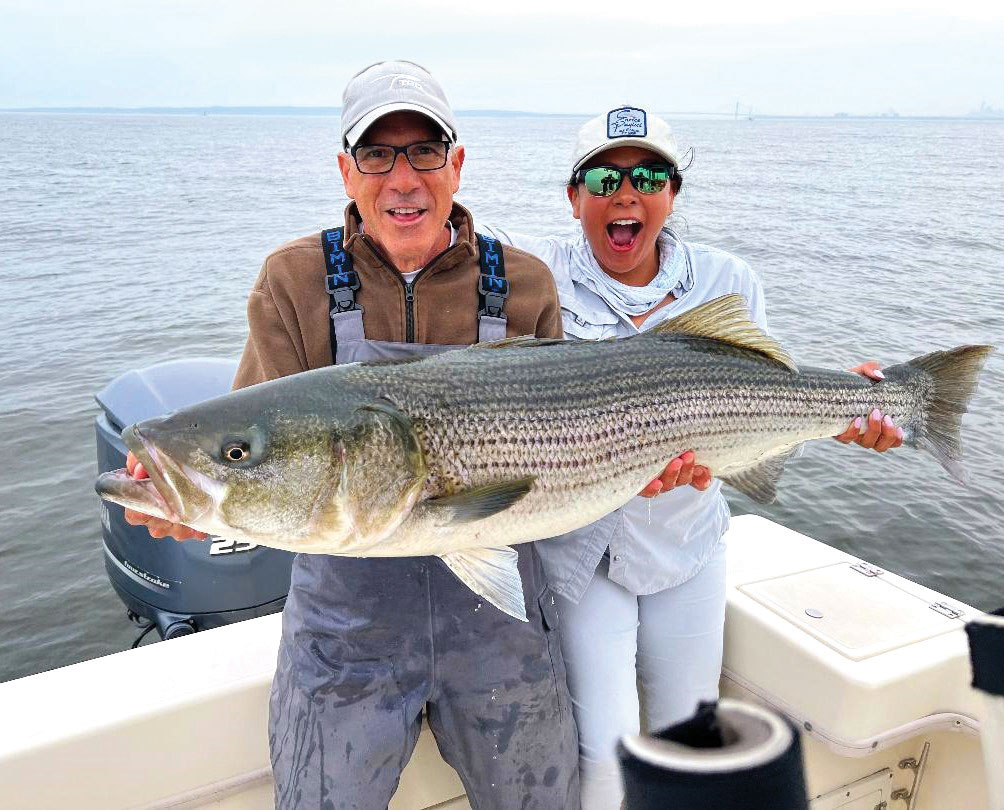
Expert local advice on using jumbo flies for the biggest stripers.
One of the most overused phrases in the world of saltwater fishing these days is “match the hatch.” That axiom was first coined in 1955 by legendary fly angler Ernest Schwiebert in his book, Matching the Hatch, and then reinforced in Art Flick’s, Streamside Guide published in 1969. The original meaning of the catchphrase was linked to matching trout flies to the relevant aquatic insects that trout feed upon, specifically, those hatches that create dry flyfishing opportunities.
Over time, the phrase match the hatch became somewhat of a universally accepted slogan for many forms of fishing, even those beyond flyfishing. Freshwater bass anglers and saltwater anglers alike embraced the concept to include matching artificial hard and soft baits to the prevalent food sources of their quarry. While the popularity of this practice grew, another time-honored mantra, “big baits, big fish,” also took center stage in the jargon of contemporary anglers.
When we marry super-size baits with matching hatch practices, we create a formula for success. Largemouth bass anglers exemplify practitioners of this theory with the use of oversized swimbaits and glidebaits. The results of their efforts are very impressive with lunker freshwater bass. Furthermore, fly anglers who target muskellunge got into the big bait game with massive flies for this top-tier member of the pike family. Those results have also been remarkable.
Without a doubt, most large specimens of any species will get aggressive with a big “bait” that appears to be in distress. Not to miss out on this opportunity, an expanding number of saltwater fly anglers fishing for Northeast striped bass have taken to casting extra-large flies to very big stripers with excellent results. But this is not an easy game. While catching school-size bass on the fly is a relatively easier task, enticing large bass between 30 and 50 pounds takes additional casting and retrieving skill, as well as a significant amount of patience, perseverance, and sometimes, a belief in miracles. But it can be done, and there is a core of anglers who regularly take up the challenge. Tristate fly anglers have the unique opportunity of accessing waters that lunker striped bass seasonally frequent.
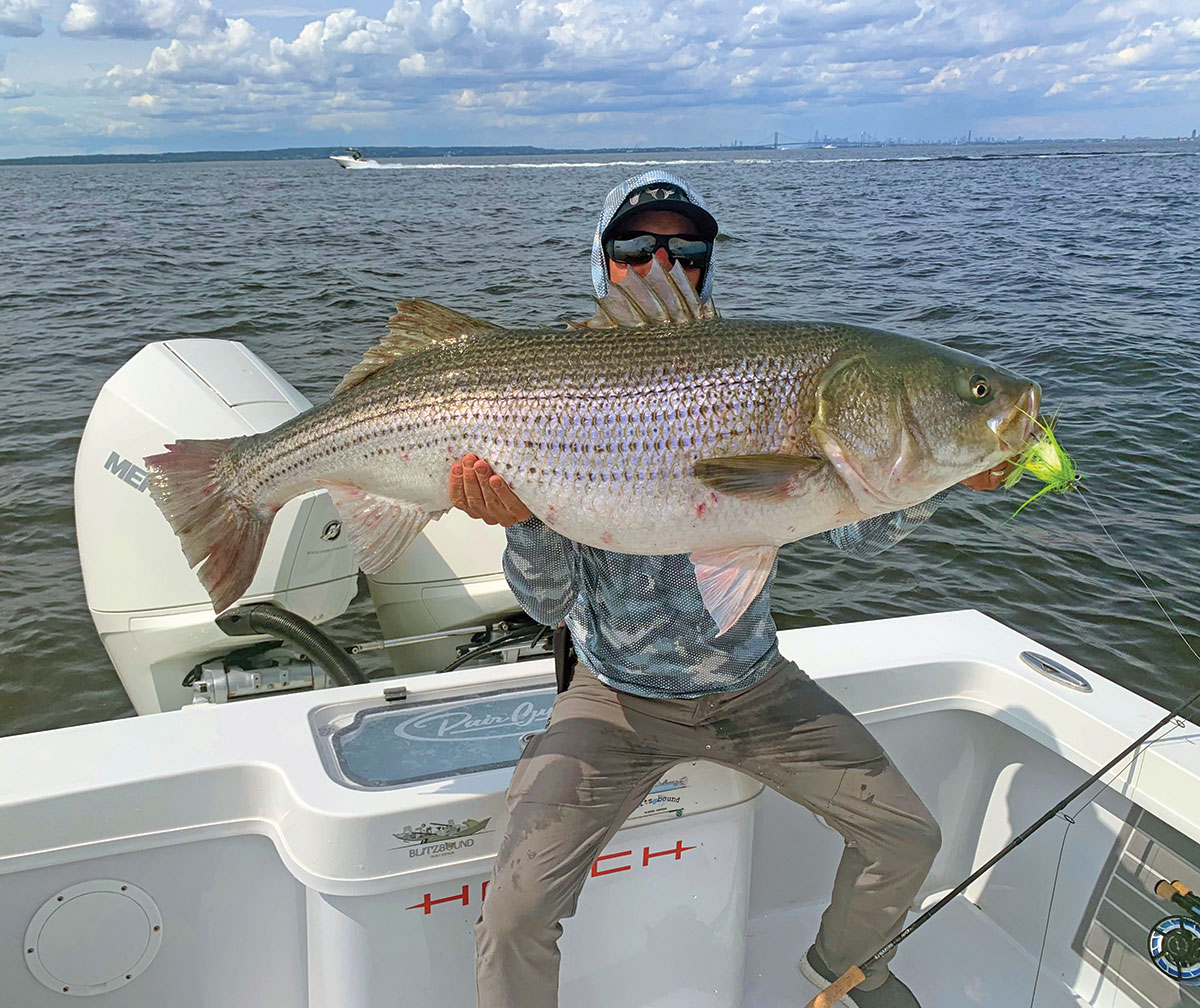
Big Fly Blitz
Capt. Jason Dapra of Blitzbound Guide Service (blitzboundcharters.com) is one of those passionate and deliberate pursuers of big bass with big flies. Jason fishes the waters of Montauk and Raritan Bay and has guided many fly anglers to their “fish of a lifetime.” Capt. Jason regularly fishes the waters of New York and New Jersey but has a strong affinity for the big bass that seasonally frequent Raritan Bay. He offers some well-earned words of wisdom for would-be fly anglers. “There truly is no better place to get a personal best striped bass on the fly than the Raritan Bay, and the New Jersey shore in spring and early summer,” said Capt. Dapra, adding “That area is loaded with adult bunker schools, and just about every day, you can find big bass feeding on those schools.”
As fly fisherman, the odds are often against us. The bait we are trying to imitate is very large, so we have to do our best to “match the hatch” by throwing big flies that are 8 to 12-inch Hollow Beast-type flies, and even at that size, they often appear on the small side. Casting flies this size can be difficult. Therefore, we do several things to improve our odds of hooking a monster. “First of all, and in my opinion, if it ain’t chartreuse, it ain’t no use,” ,” said Capt. Dapra, adding “Especially in the spring, the color of the water is not exactly clear, so I find it very bright pattern out-fishes all other colors.”
Since there is not much structure to work, Dapra said the fish will be on the roaming bunker schools, which sometimes could be anywhere from the back of the bay to 20 miles down the beach. “When you pull up to bunker school, you need to identify if they are happy, stress-free bunker, or nervous bunker, about to get blown up by feeding bass,” he said, adding “Much of the time, we will be able to mark larger fish under the bait schools, so heavy, sinking lines will be the play. This line game is all about being relentless and believing that your fly is going to get eaten in the deep.”
Dapra said it can get tiring – maybe even a little boring – throwing a heavy sinking line, letting it sink, and stripping it over and over again, but he said you need confidence that a big bass will eventually find your fly and eat. “I also like to put the throttles down and run, looking for any school that is showing surface activity. Once we find a school that is active, I will throw a hookless teaser plug to try to get the fish riled up.” At that point, Dapra said his anglers will continuously make their casts in hopes a big bass finds their fly.
“In the spring, we use 10 weights with intermediate lines and 10- and 11-weights with 350-grain and 450-grain sinking lines. Being a proficient caster makes a huge difference,” said Capt. Dapra. “If you can get a fly out 80 feet as opposed to a lazy 40-foot cast, your fly will be in the water twice as long. The more time that fly is swimming, the more time a bass has to find it, and with persistence, they will,” he added.
Two of Capt. Dapra’s regular clients are fully dedicated to the pursuit of monster bass. The brothers, Joey and Jesse Walter have many such fish under their belts, including three bass between 49 and 50 pounds. One of Capt. Jason’s line tips that should be reinforced is that of utilizing high-grain sinking lines. Back when I first started to fish for Alaskan Chinook salmon in big water with heavy currents and significant depth, the advice that I received from one of the lodge guides was, “If you want to catch big King Salmon consistently on the fly, you need to learn how to cast and fish 300- to 450-grain sinking lines. That was sage advice that holds true for big striped bass. Those lines are an important part of the fly angler’s toolbox.
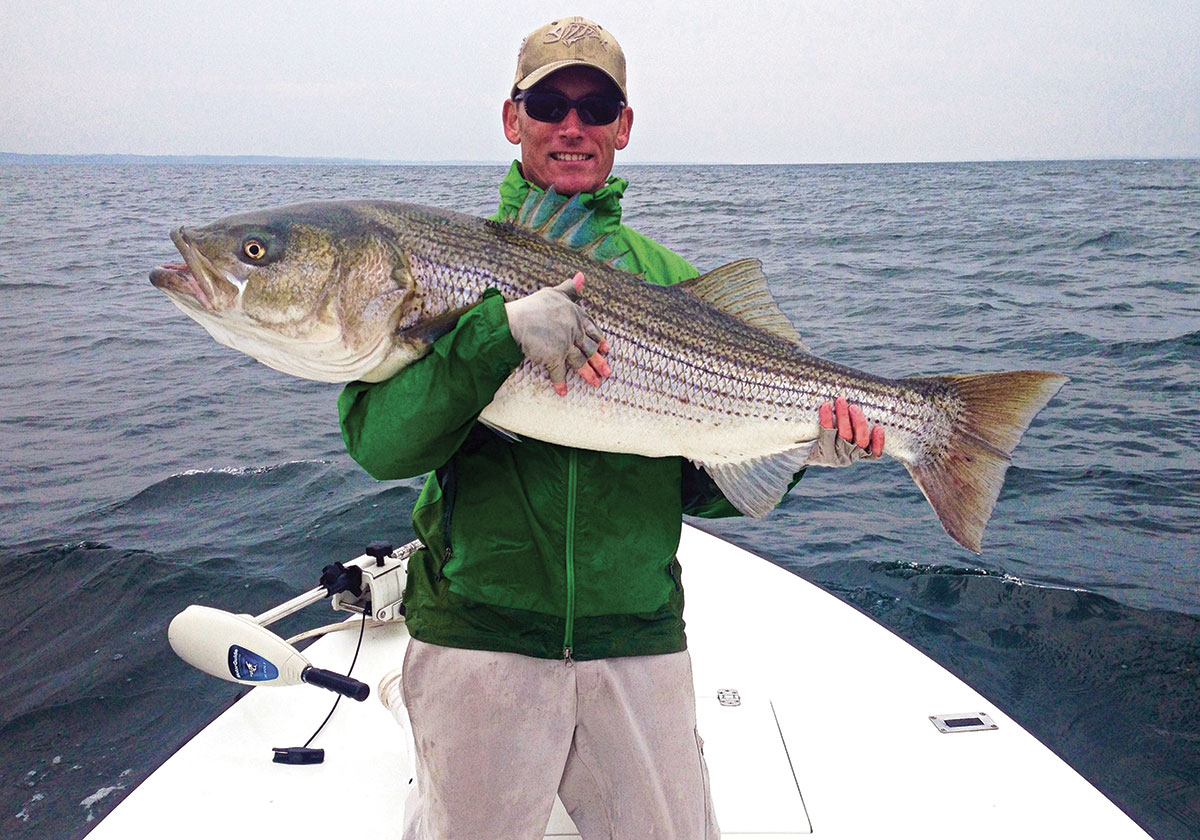
Tips & Strips
Capt. Joe Mustari of Mazman Charters (mazmancharters.com) has been guiding fly anglers for striped bass for more than 40 years, and he has gained a reputation as one of the very best at the big bass game. He offers some well-learned lessons from that extensive period of chasing large fish: “The key to catching large trophy striped bass on the fly is to never get discouraged,” Capt. Mustari, explaining how that’s not an easy task by any means. “I have anglers sometimes throwing 8- to 12-inch flies for hours without a bite while watching others catch one after another on live bait or huge plugs. It’s frustrating to watch, and most people just give up and grab the spin tackle,” he said.
“When I take people to fly fish for big bass, I explain the difficulty level and let them know we are fishing for probably one bite, and it’s a long shot unless you find them blitzing baits on top. Then it’s actually pretty easy,” Capt. Mustari said, noting how the pay-off is the chance to catch that trophy striper of a lifetime on the fly.
Capt. Mustari added, “To be successful at this, you must be relentless. I mean, you need to be totally focused on the task. You must keep casting and retrieving non-stop, sometimes for hours without a break. You have to visualize that monster striper following your fly on every retrieve and figure out how to get that fish to bite. Constantly change up the retrieve technique to find something that might work. I generally like a faster, more erratic retrieve with multiple pauses, and I will switch it up from a one-hand to a two-hand retrieve. I have had some really great casters onboard the Mazman. What I always tell them is, it’s not how you get it out there, but how you bring it back that counts.”
Capt. Joe Mattioli of On the Bite Charters (fishingnyc.com) is another prominent guide who fishes for big bass in the waters of New York and New Jersey. “It’s no secret that big bass love to eat bunker. So, match the hatch with a bunker fly,” Capt. Mattioli told me.
“I tie and use weighted synthetic bunker flies. They shed water quickly as you cast them and are less fatiguing,” Capt. Mattioli said, explaining how the other benefit of synthetic is that these flies also begin to sink immediately and maintain a consistent descent with your sinking line. “Search for the tightest balled-up bunker school or, better yet, one that has obvious signs of fish crashing through (white water is the clue),” Capt. Mattioli, advising fly anglers to use a 300- to 500-grain full sinking line, casting the fly into the middle of the school and letting it sink below the bunker.
“The strip method varies; sometimes, they like it fast with long, quick strips, and other times, they like it really slow with 5-inch slow strips,” Capt. Mattioli said, adding “Mix it up until you home in on what they want.”
There are a number of common themes that run through the advice given by the above-referenced guides. Those tidbits of wisdom are worth repeating. The success of the fly angler in hooking and landing big striped bass is in many ways contingent upon the following elements: Persistence in pursuit of the goal; relentless casting and fishing through challenging conditions; the use of high-density sinking lines; varying the rate and tempo of retrieves; confidence that a fish will strike the fly; and just a little bit of luck.
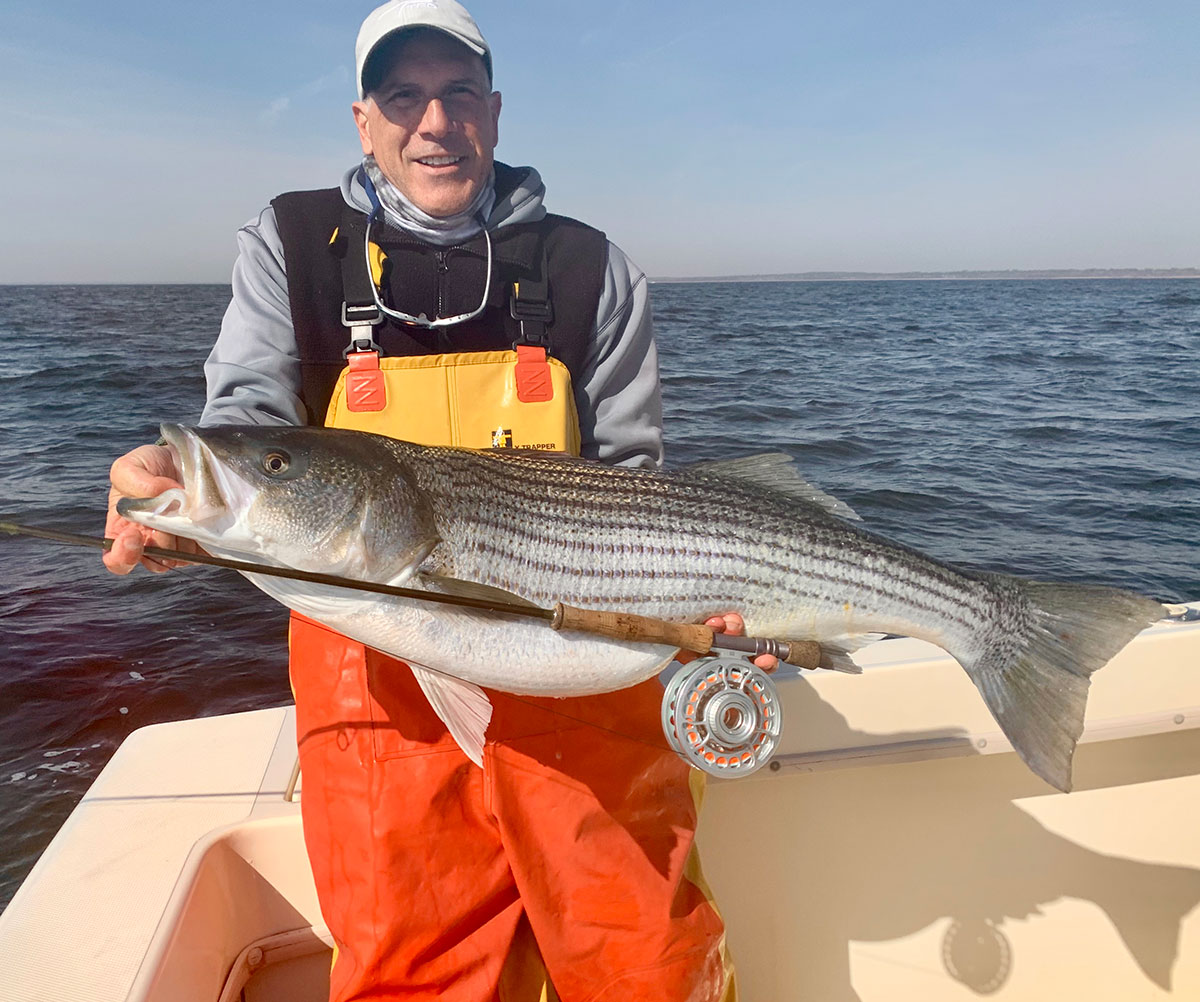
The Business End
Although there is renewed interest among a core of avid fly anglers in pursuing stripers with big flies, there are a number of early pioneers of the big bass game who had, at the time, broken new ground with their patterns. Two of the most prominent of those regional innovators were New Englanders Bill Catherwood and Bill Peabody. Catherwood was most known for his 1950s series of “Giant Killer” flies, while Peabody originated one of the first full-bodied bunker patterns named Bill’s Bunker fly. These flies maintained a long and storied history as consistent producers of big bass.

Mark Sedotti, a regular contributor to The Fisherman Magazine, is a renowned fly caster and angler who has a demonstrated affinity for catching big fish on big flies. He is also the originator of the Slammer Series of large flies that have a proven track record for enticing big striped bass. Two of Sedotti’s most effective big fish flies that mimic adult menhaden are the Feather Slammer and Synthetic Slammer, both of which can be tied to a length of about twelve inches or longer.
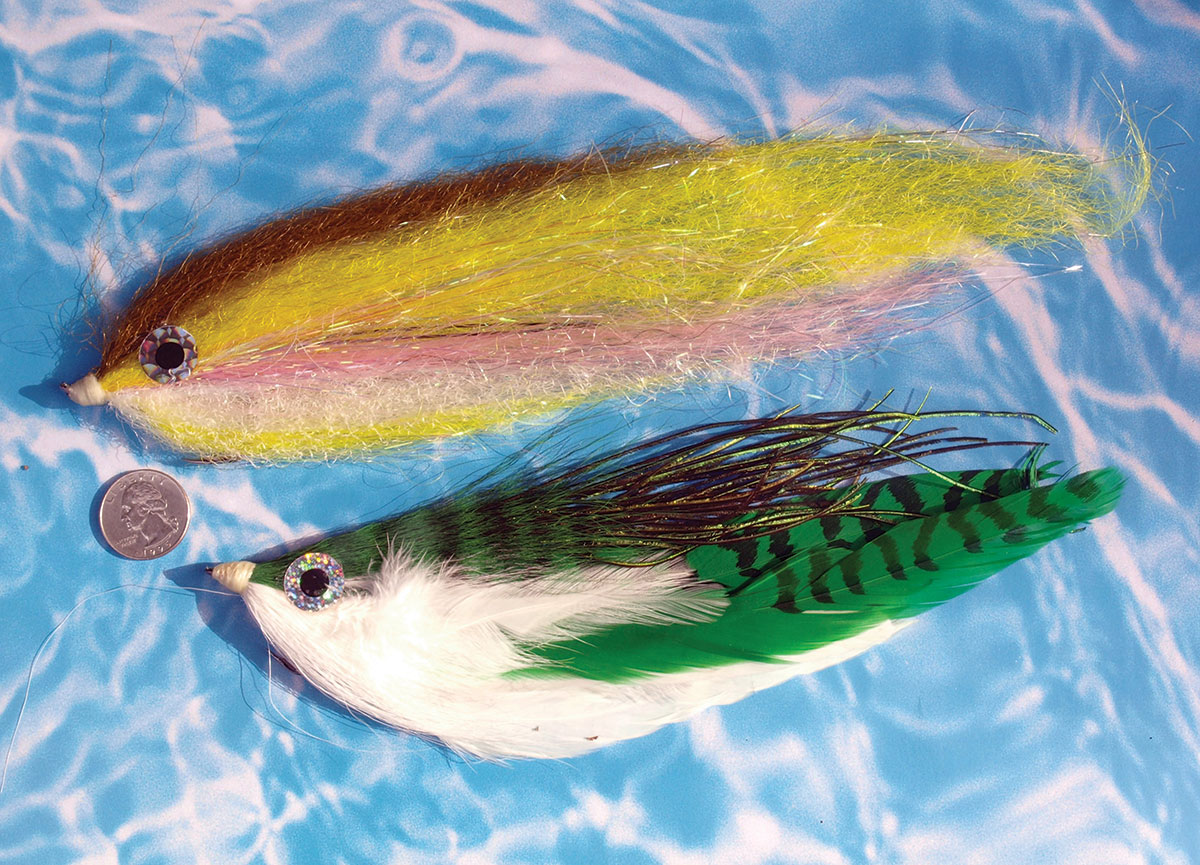
New Jersey’s Bob Popovics is an internationally recognized fly tyer and angler who has been at the forefront of northeast saltwater fly fishing. He is one of the most preeminent fly innovators of our time and has designed many effective saltwater flies. Two of his high-performing patterns for big striped bass are the Buck Tail Deceiver and the Hollow Beast Fleye. Both fly styles maintain their large bait profile while being relatively light and very castable. Popovics’ designs also display very tantalizing motion when retrieved, an action that big bass often find irresistible.
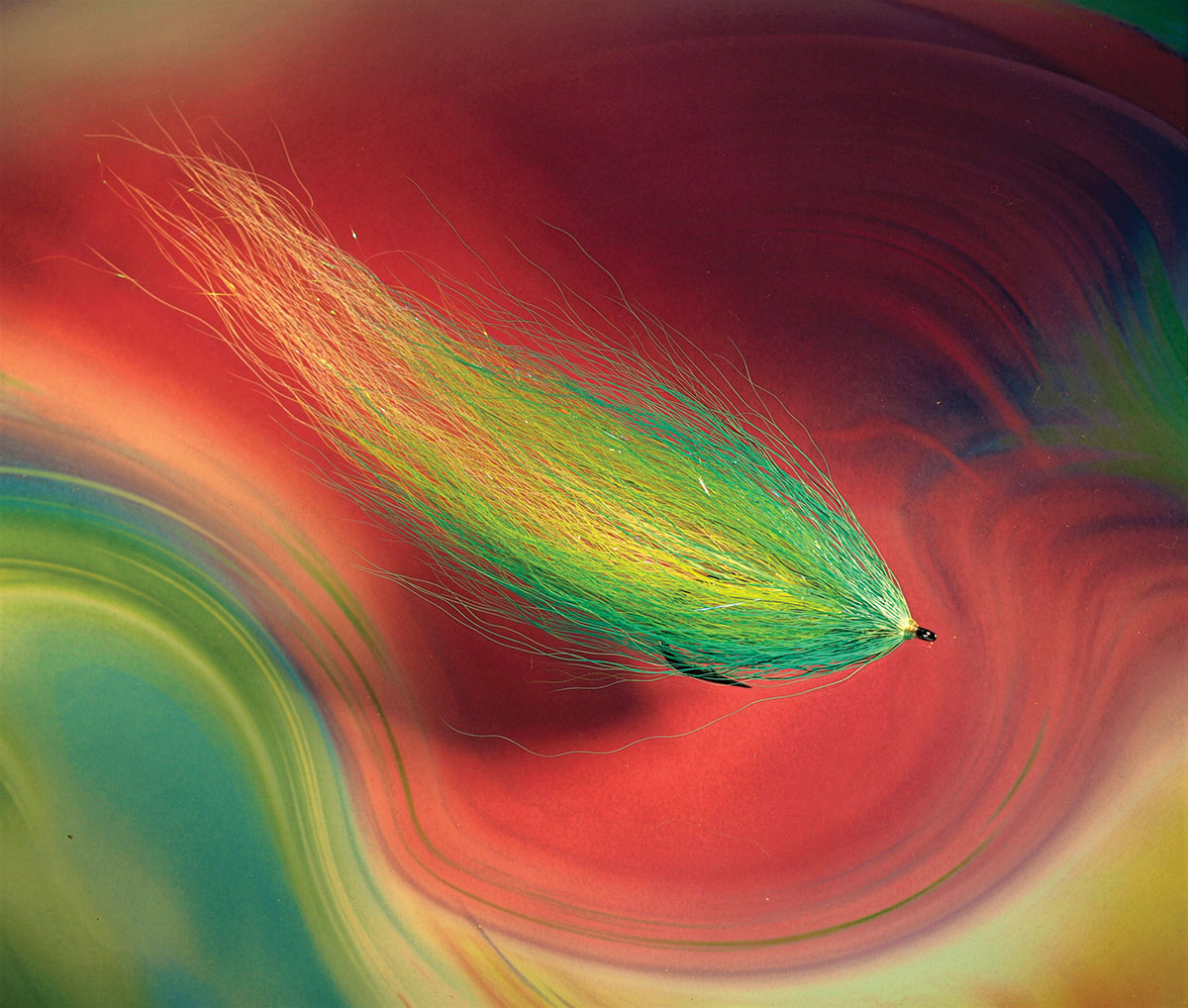
Capt. Ian Devlin operates Devlin Fishing Charters and commercially ties flies created from his proprietary Devlin Blends, a material that is very suitable for thing large flies. Devlin spends most of his time fishing the waters of the Long Island Sound and is one of the region’s best fly fishing and light tackle guides.
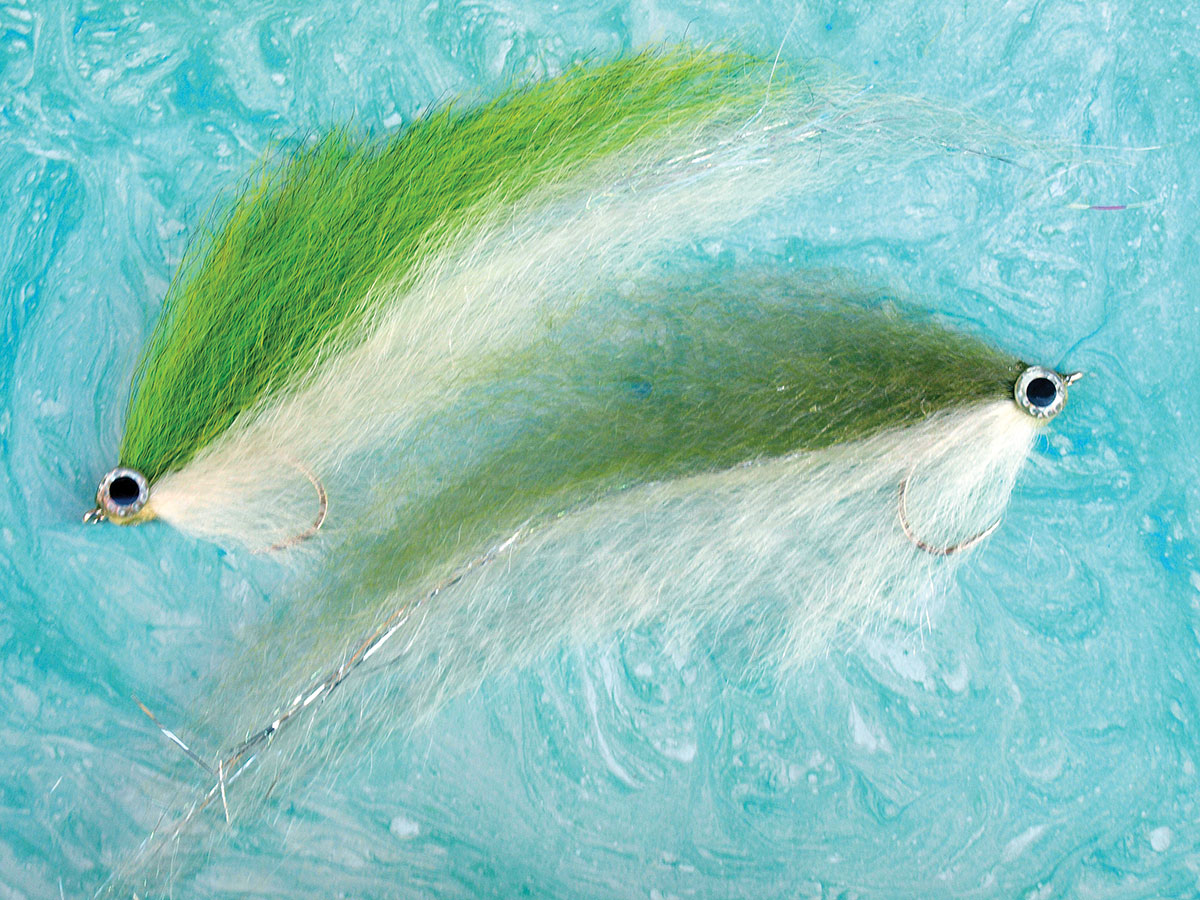
Inspired by the work of Bill Catherwood, and committed to keeping Catherwood’s big fly traditions alive, Joe Calcavecchia has developed his Striper Dragon series of flies. The spun deer hair head flies push water and send vibrations big bass can’t resist. Joe ties the Dragon from 6 inches in length to over 8 inches, as well as many other patterns that have proven effective for large striped bass.
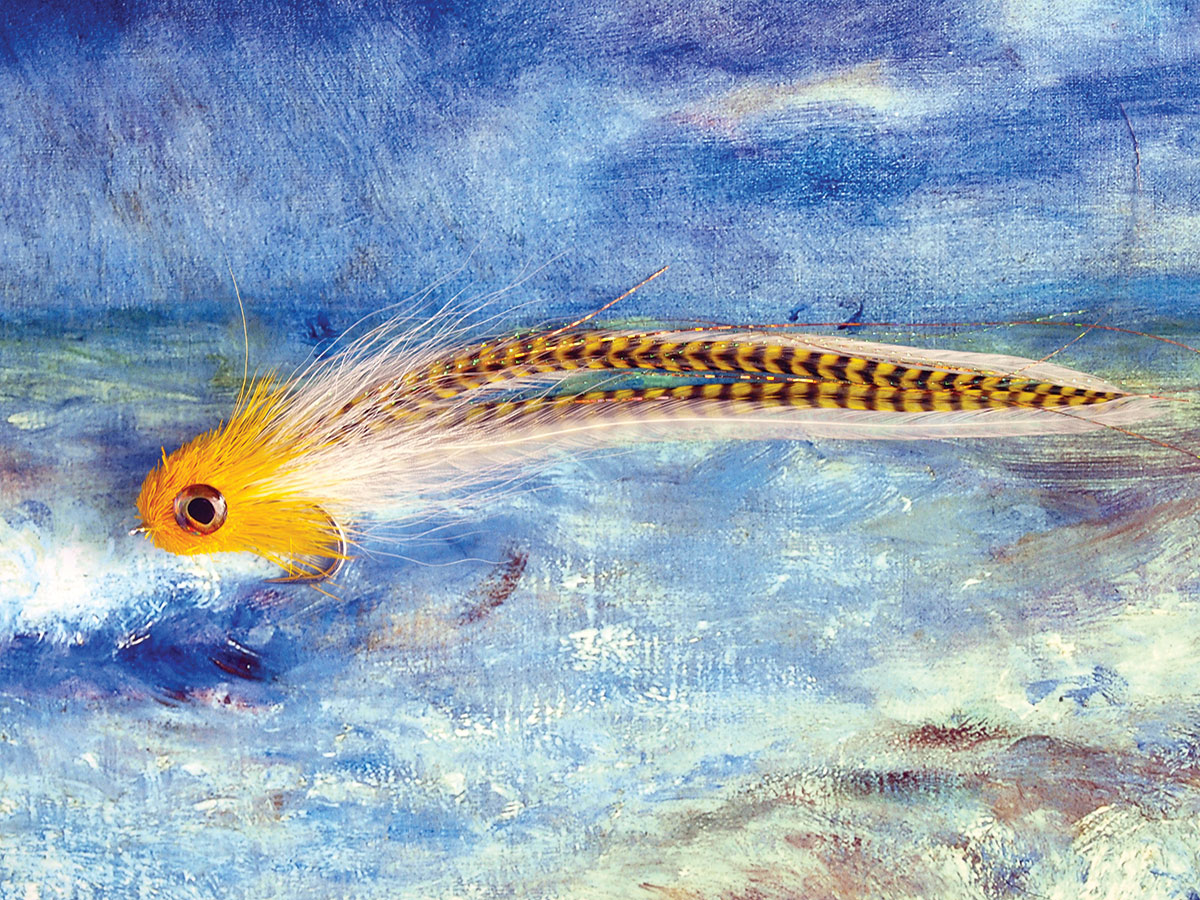
In addition to large hair, feather and synthetic flies, over-size offshore-type poppers are also very effective when large bass surface fee on adult menhaden. These poppers require the use of at least 10/11-weight rods and heavy weight-forward lines. But they make topwater commotion and can replicate panicked splashing of harried bunker.
